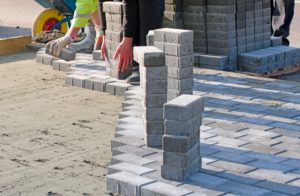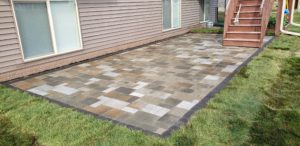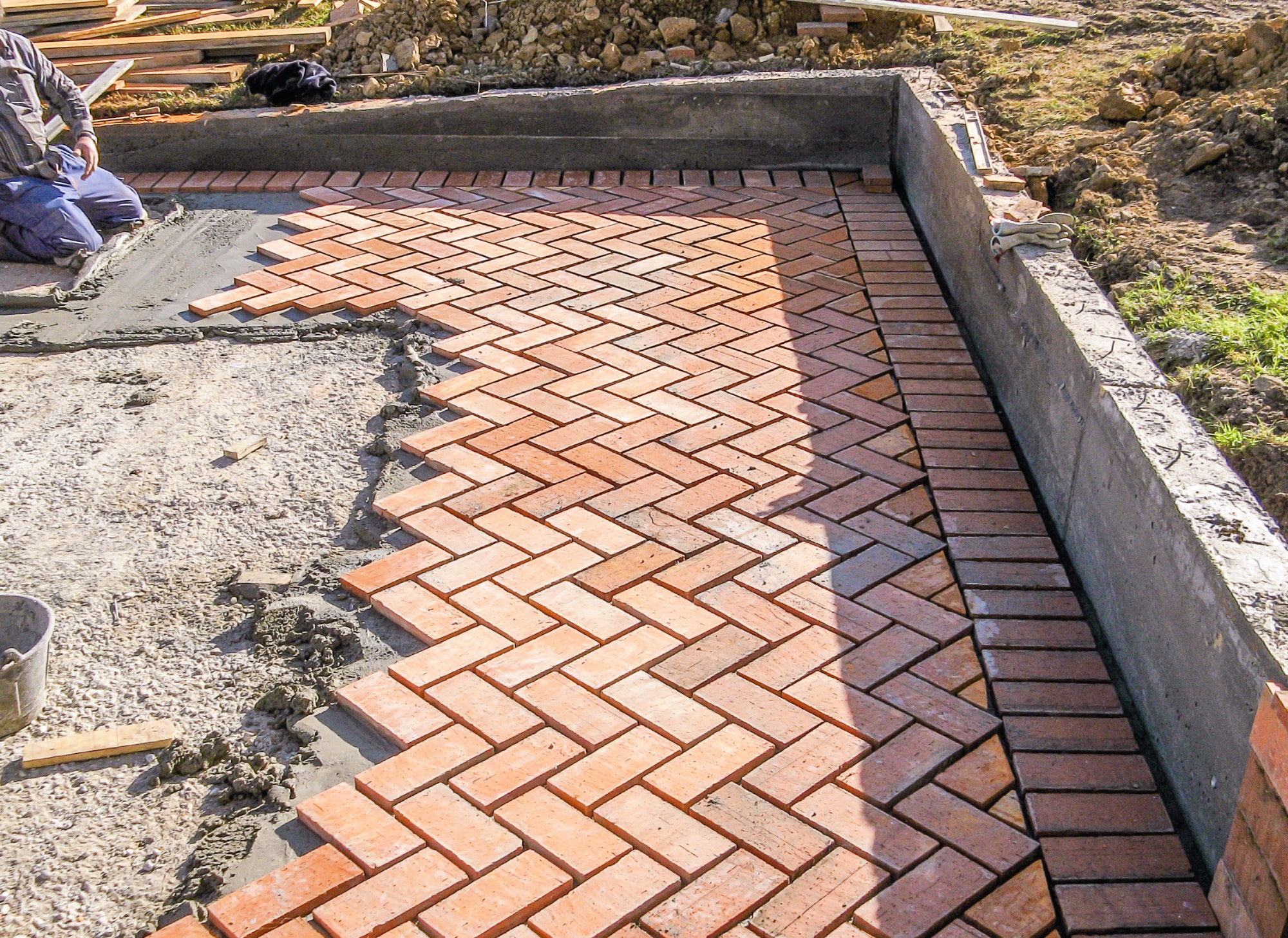Paver patios and walkways add an extra element to landscapes that is unrivaled. There are endless patterns, colors, and styles of pavers that simply cannot be achieved with stamped concrete. Pavers can be used in the landscape for patios, walkways, driveways, courtyards, pools, and sidewalks. If installed properly, paver patios can last just as long or longer than concrete can.
Paver Patios Construction
When installing paver patios, proper construction is vital to ensuring the longevity of the space. The first step is to survey the area to determine the slope. If laid near a house foundation, the pavers should slope a minimum of at least 1/8 of an inch per foot away from the house and generally no more than ¼ of an inch. If the slope of the land is too great, then a retaining wall may be needed to build paver patios that fall within the proper slope of the area.
Patios with a slope greater than ¼ inch per linear foot may be too sloped to use in an outdoor leisure space. The exception with slope is often used on pathways, sidewalks, and driveways. Since users don’t generally spend a lot of time and have patio furniture in these areas, a larger slope is considered tolerable. The best way to determine slope is to use a laser level or a transit. This tool can calculate the slope over a given area down to as close as 1/64th of an inch.
How Deep Do We Dig Under Paver Patios or Walkways?
Once the desired slope of the area is determined, excavation of the area can begin. At this step, you should have your pavers chosen to know how deep the area needs to be excavated. For proper installation of pavers where only foot traffic is expected, excavation of at least six inches plus the depth of the paver should be completed. This is considered relative to where to where you would like the top of the paver to be relative to the rest of the landscape.
Our company, TeBock’s Landscape generally aims to have the pavers about one inch above the soil lawn level. Having them at this height keeps the grass from growing over the paver patio in the future. Where heavy vehicle traffic is desired, excavation of at least 12 inches is desirable plus the depth of the paver.
Compacting the Soil
After excavation is complete, a plate compacter should be used to compact the bare soil. If excavated properly, there should be no loose soil where the paver patio is going to be placed, but this will help to ensure a solid pad to install the patio on. After compacting, woven polypropylene fabric should be placed on top of the soil. Paver base should then be added on top of the fabric. Add about 2-3 inches of paver base at a time and ensure that it is compacted thoroughly in multiple directions after each layer using a plate compactor. If paver patios are being built with a retaining wall, do not use the excavated patio soil to backfill where pavers are going to be placed. Compacting soil is much more difficult than compacting paver base.
Keeping Level Base Layers

As you build each layer of base for your paver patio, try to keep as consistent depth as possible to make plate compaction more uniform. After the final layer of paver base is installed, use a screed to begin leveling the area. At this point, we like to use grading pins and our transit to make sure that we are building the patio with the correct pitch for water flow (1/8-1/4 of an inch). Your screed should be able to touch the pins to ensure the grade is correct. After the grading is complete, the paver base should be thoroughly compacted.
After the base is set, a rail system using ¾ conduit can be placed on top of the paver base. Because the conduit is ridged, it acts as a final leveling system for the pavers to be set on. Sand is placed on top of the paver base and on top of the conduit and the screed is placed on the conduit. The sand can then be pulled over the patio. After the sand is leveled, the conduit can be pulled up and sand is placed in the void. That sand is then leveled by hand or using a trowel. Pavers can then be laid on top of the bed of sand.
Paver Styles
There are many styles of pavers to choose from.
Holland Pavers
Holland pavers are usually the most economical type of pavers used in landscapes. They are all the same shape and size and most come in 4×8 inches. Holland pavers can be laid in a running bond or herringbone pattern. To accent the Holland pavers, a soldier course of a contrasting color can be laid on the perimeter of the patio or walkway. Holland pavers are a simple pattern and are commonly used in driveways, patios, walkways, and even some city streets.
Three-piece Paver Systems
For customers looking for a medium cost paver, a three-piece system can be used. Most three-piece paver systems have three different shapes of squares and/or rectangles that are used in a specific pattern. Three-piece paver systems give a very elegant look to landscapes and add many lines and shapes. A three-piece paver can also have a border placed on it. Great border options for three-piece paver systems include Holland pavers as well as 6×9 accent pavers. Three-piece pavers come in both smooth and textured. Depending on the application and the preference of the homeowner, either style can be used. Smooth pavers are great next to pools and patios while textured pavers may be a great option for walkways.
Cobblestone Pavers
Cobblestone pavers are another option for landscapes. While not widely used as much in today’s landscape due to many new paver styles, cobble stone pavers were widely used in landscapes 10-20 years ago. Cobblestone pavers come in up to six different sizes. This paver system does have the most patterns available due to the number of sizes available. While any paver style can be cut into a circle, cobblestone pavers also come in a circle kit where no cutting is required. This is great for homeowners who are looking for a DIY project.
Geometric Pavers
Another common paver used in modern landscapes are geometric pavers. These pavers can come in a variety of shapes and sizes including flagstone shaped, diamond shaped, and even molded to look like planks of wood. These types of pavers can be inlaid within other types of pavers for a specific contrast in your outdoor space.
Applying Polymeric Sand
The final step in building a paver patio or walkway is to apply polymeric sand. Polymeric sand is a material used to fill the joints in pavers. This product comes as a dry powder and gets swept into the joints. Once the paver joints are filled, water is applied to the polymeric sand which then starts a reaction with polymers within the sand. As the sand dries, it hardens and adheres to the pavers and acts like a glue to keep the pavers from moving. Polymeric paver sand comes in multiple colors of tan and gray. Polymeric sand also acts as a barrier, so weeds do not grow in the paver cracks.
Permeable Pavement
Another use for pavers in the landscape is the ability to use pavers for permeable pavement. Permeable pavement is a system that allows water to drain between the cracks of the pavers and soak into the ground. Alternatively, with concrete water flows over the surface and into lawns or storm sewer systems. Permeable systems allow water to soak into the ground and can help with areas that are prone to high runoff or areas that don’t drain well during rain showers.
If you are interested in a quote for a paver patio or walkway, give TeBock’s Landscape a call at 515-809-0690 or send us a message here.







